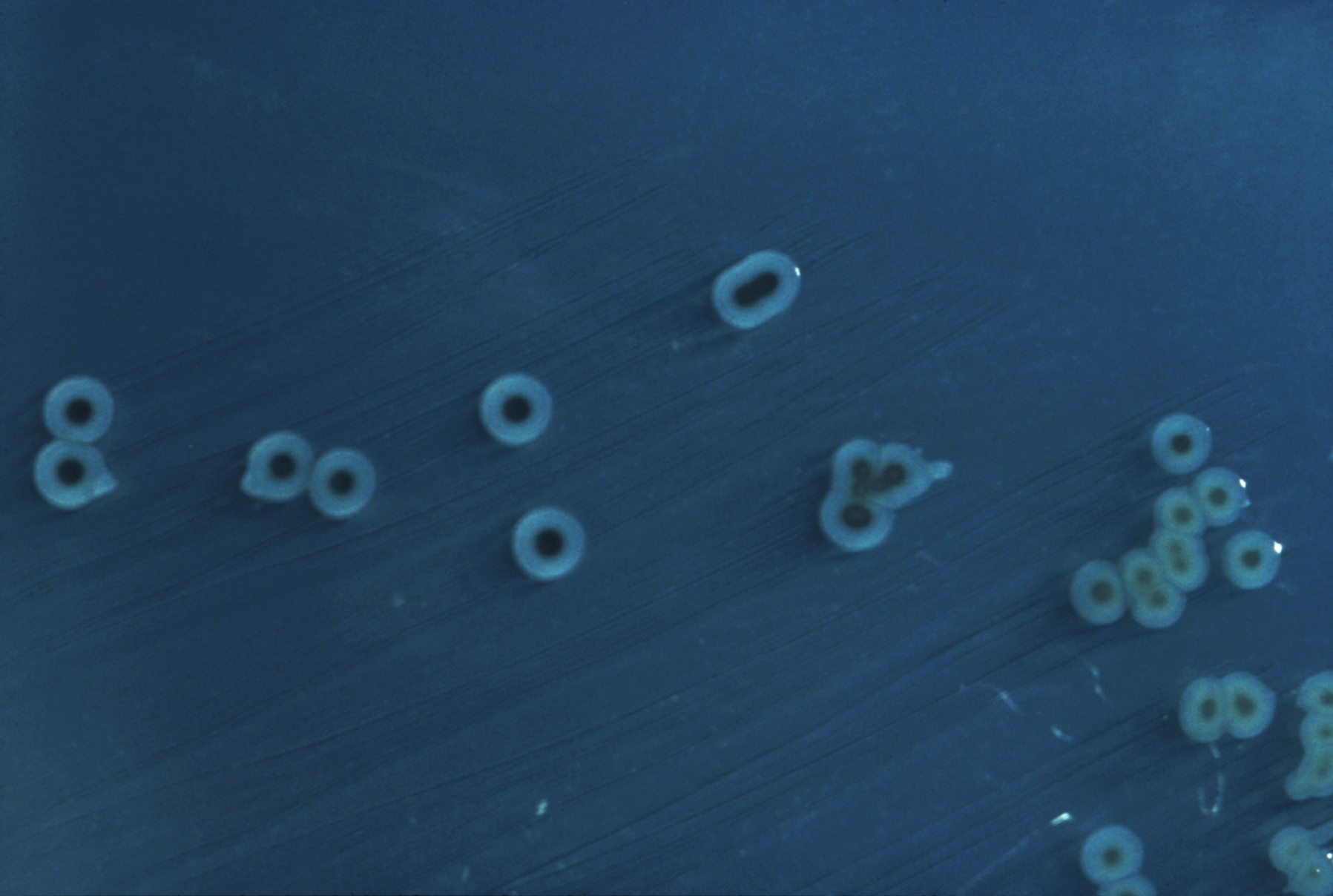- Salmonella enterica
Taxobox
color = lightgrey
name = "Salmonella enterica"

image_width = 240px
image_caption = "S. enterica" Typhimurium colonies on a Hektoen enteric agar plate
regnum = Bacteria
phylum =Proteobacteria
classis = Gamma Proteobacteria
ordo = Enterobacteriales
familia =Enterobacteriaceae
genus = "Salmonella "
species = "S. enterica"
binomial = "Salmonella enterica"
binomial_authority = (ex Kauffmann & Edwards 1952)
Le Minor & Popoff 1987"Salmonella enterica" is a rod shaped,
flagella ted,Gram-negative bacterium , and a member of thegenus "Salmonella ".cite book | author = Giannella RA | title = Salmonella. "In:" Baron's Medical Microbiology "(Barron S "et al", eds.)| edition = 4th ed. | publisher = Univ of Texas Medical Branch | year = 1996 | id = [http://www.ncbi.nlm.nih.gov/books/bv.fcgi?rid=mmed.section.1929 (via NCBI Bookshelf)] ISBN 0-9631172-1-1 ]erovars
"S. enterica" has an extraordinarily large number of "
serovar s" or strains—up to 2000 have been described.cite book | author = Ryan KJ; Ray CG (editors) | title = Sherris Medical Microbiology | edition = 4th ed. | publisher = McGraw Hill | year = 2004 | id = ISBN 0-8385-8529-9 ] "Salmonella enterica" Serovar Typhi (historically elevated tospecies status as "S. typhi") is thedisease agent intyphoid fever . Other serovars such as Typhimurium (also known as "S. typhimurium") can lead to a form of humangastroenteritis sometimes referred to assalmonellosis .The
genome sequence s of serovars Typhicite journal | author=Parkhill J "et al". | title=Complete genome sequence of a multiple drug resistant "Salmonella enterica" serovar Typhi CT18 | journal=Nature | year=2001 | pages=848–52 | volume=413 | issue=6858 | pmid=11677608 doi|10.1038/35101607 | doi=10.1038/35101607 ] and Typhimurium LT2cite journal | author=McClelland M "et al". | title=Complete genome sequence of "Salmonella enterica" serovar Typhimurium LT2 | journal=Nature | year=2001 | pages=852–6 | volume=413 | issue=6858 | pmid=11677609 doi|10.1038/35101614 | doi=10.1038/35101614 ] have been established. Also an analysis of theproteome of Typhimurium LT2 under differing environmental conditions has been performed cite journal | author=Adkins JN "et al" | title=Analysis of the "Salmonella typhimurium" Proteome through Environmental Response toward Infectious Conditions | journal=Molecular and Cellular Proteomics | year=2006 | pages=1450–1461 | volume=5 | pmid=16684765 | doi=10.1074/mcp.M600139-MCP200 ] ."Salmonella" Typhi
"Salmonella" Typhi is a
serovar of "Salmonella enterica" (formerly known as "Salmonella choleraesuis") and the cause of the diseasetyphoid fever . The organism can be transmitted by thefecal-oral route —it is excreted by humans infeces and may be transmitted by contaminated water, food, or by person-to-person contact (with inadequate attention topersonal hygiene )."Salmonella" Typhi possesses three main antigenic factors: the "O", or somatic antigen; the "Vi", or encapsulation antigen; and the "H", or flagellar antigen.Fact|date=February 2007
Epidemiology
Most cases of salmonellosis are caused by food infected with "S. enterica", which often infects
cattle and poultry, though also other animals such as domesticcat s andhamster s [cite journal | volume=356 | pages=21–28 | year=2007 | issue=1 | title=Multidrug-resistant "Salmonella enterica" serotype Typhimurium associated with pet rodents | author=Swanson SJ, Snider C, Braden CR, "et al." | url=http://content.nejm.org/cgi/content/short/356/1/21 | pmid=17202452 | doi=10.1056/NEJMoa060465 | journal=New England Journal of Medicine ] have also been shown to be sources of infection to humans. However, investigations ofvacuum cleaner bags have shown that households can act as a reservoir of the bacterium; this is more likely if the household has contact with an infection source, for example through members working with cattle or in a veterinary clinic.Raw chicken and goose eggs can harbor "S. enterica", initially in the whites of the eggs, although most eggs are not infected. As the egg ages at room temperature, the yolk membrane begins to break down and "S. enterica" can spread into the yolk. Refrigeration and freezing do not kill all the bacteria, but substantially slow or halt their growth. Pasteurizing and
food irradiation are used to kill "Salmonella" for commercially-produced foodstuffs containing raw eggs such as ice cream. Foods prepared in the home from raw eggs such as mayonnaise, cakes and cookies can spread salmonella if not properly cooked before consumption. SeeEgg (food) .pace bacteria
On
September 25 , 2007, Cheryl Nickerson (Center for Infectious Diseases and Vaccinology) atArizona State University stated thatspace bacteria "Salmonella" Typhimurium (food bugs/bacteria, on their 12-dayAtlantis orbiter flight , September 2006) were found to change the way they expressed 167genes (regulated by aprotein Hfq ). It gained 3 timesvirulence than onearth . [ [http://news.bbc.co.uk/2/hi/science/nature/7011828.stm BBC NEWS, Space bugs become more dangerous] ]ee also
*
1984 Rajneeshee bioterror attack
*Contamination control
*Typhoid Mary References
External links
* [http://www.bacterio.cict.fr/salmonellanom.html Notes on "Salmonella" nomenclature]
Wikimedia Foundation. 2010.
